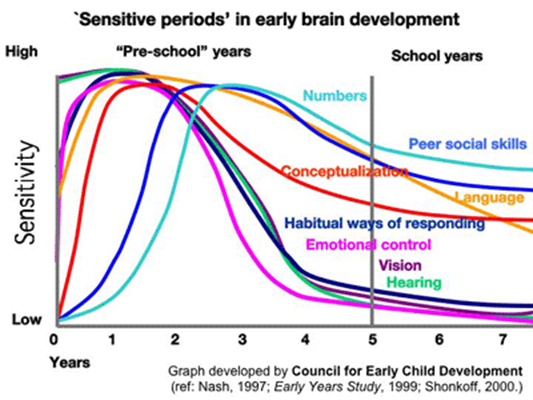Brain Development
Important Brain Development Terms
- Brain plasticity - The amazing ability of a developing brain to reorganize itself. The cerebral cortex (or higher brain) can adapt to another section to take over the functions of a damaged section. This ability diminishes with age, although research has shown that even the brains of older adults can reorganize some and produce a few new neurons after damage (Kolb & Gibb, 1999).
- Pruning- Neural connections that are unused get “pruned away” and circuits that are active get stronger. The brain builds itself through a “use it or lose it” principle. Most of it happens in early childhood.
- Lateralization - How the two sides, or hemispheres, of the brain specialize to have different functions. This division of tasks begins at birth but is also determined by early experiences, as all of brain development seems to be.
- The left hemisphere specializes in analytical thought, logic, and reasoning, and controls the right side of the body. This is the dominant side in right-handed people.
- The right hemisphere controls feelings, intuition, and imagination as well as the left side of the body. Left-handed people are dominated by this side.
Sensitive periods exist in brain development despite plasticity. The brain is expecting certain experiences in order to make vital connections.
VISION - Two to four months. That’s why it’s essential to have infants’ vision problems such as a wandering eye) corrected if needed.
LANGUAGE - Birth to age five. At first, neonates can distinguish between all the sounds in human languages, including sounds that we can no longer hear since they are unused in English. When the baby becomes sensitized to the sounds of her own language, the unused connections are pruned (between six and twelve months). By one year of age, neurons needed for the native language are permanently in place. Fascinating recent research at the University of Washington found that babies who were exposed to foreign language sounds on a regular basis retained the ability to hear these sounds. The really fascinating part is that babies did not learn from videos or audio recordings. Only the infants who interacted with a live person could still hear the foreign language sounds at older ages (Kuhl, Tsao, & Liu, 2003).
MUSIC - Three to ten years is when a musical instrument can be learned most easily. Some studies have shown a connection between music and math abilities.
EMOTIONAL — Birth to 18 months. This is one of the first of the brain’s circuits to develop, since social attachment and emotional regulation begin at birth. The first emotions are simple distress and contentment, which rapidly develop into more complex and varied emotions. When an infant feels safe and cared for, she or he can focus on exploration rather than getting his or her needs met. This leads to a healthy attachment, which will be detailed in the section on emotional development.
MATH AND LOGIC - One to four years. The understanding of numeric and analytical concepts occurs during the preschool years when children are in stimulating environments. If not given these opportunities, children may struggle in this area in the future.
